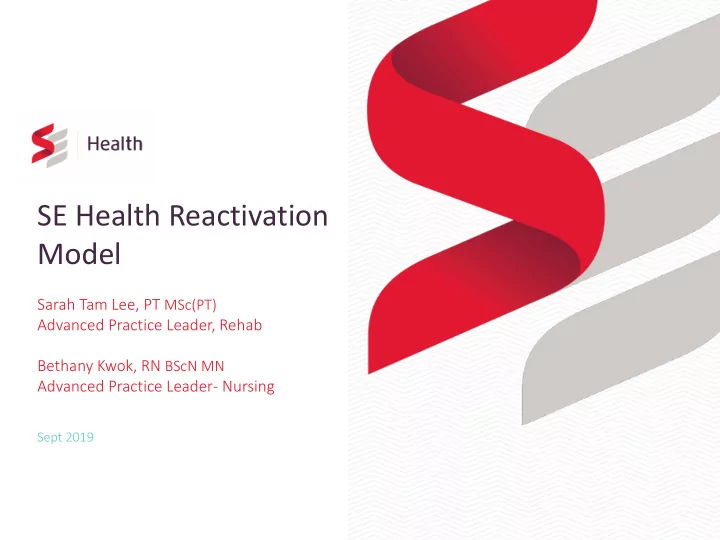

SE Health Reactivation Model Sarah Tam Lee, PT MSc(PT) Advanced Practice Leader, Rehab Bethany Kwok, RN BScN MN Advanced Practice Leader- Nursing Sept 2019 1
SE Health 111 Years of forward thinking 9,000 Leaders of Impact 20,000 Home visits a day CANA NADA’S L S LAR ARGEST ST DIVERSI SIFIED HEALT LTHC HCARE E COM OMPANY & Y & SOCIAL L ENTE TERPR PRISE 2
SE Reactivation Model of Care Philosophical approach to Care Integrated, Collaborative Care Return to Interdisciplinary Community Planning Team Older Client, Family, Canadians Functional Caregiver Living with Mobility Engagement Frailty Outcome Based Client-Centred Care Care Self Care 3
SE Reactivation Model of Care Prog ogram am G Goal oals • To decrea ease E e Emer ergen ency D Dep epartm tment visits or readmissions • Ret eturn to to p previous l lev evel el o of f functi tioning g OR manage ge with new level of functioning • Support s t safe t e transitions and ret eturn to to c community 4
Clinical Models SE Health Reactivation Model is tailored to meet the needs of older adults living with frailty in collaboration with our partners Facility-Based Model •Recovery in a facility-based reactivation program •A community and person-centred focused approach to optimize capability and return to community Retirement-Home Model •Recovery in a controlled, supported ‘like-home’ setting •Focused on transitioning Home Retirement-Home & Homecare Model Two Stages 1. Recovery in a controlled, supported facility-based setting 2. Transition to an integrated homecare team 5
Overview of Program Rehabilitative Facility/Recreational Medical Activities Activities Management • Nursing Care • Group-based • Encourage Activities participation in all • Primary Care activities offered Provider • 1:1 interventions by the Home/Facility Client & ADL/IADL Support Team Meetings Family/Caregiver Involvement • Personal Support • Goal Notebook • Huddles • Rehab support • Family conference • Rounds 6
EVALUATION 7
Client Profile Client Profile in SE Reactivation Programs % who experience daily pain % who exhibits Unsteady Gait Fell in Last 30 Days % of individuals with chronic conditions not well managed % who presents with cognitive decline Requires help with ADLs such as bathing, dressing Requires help with IADL such as shopping, banking % who doesn’t have an informal caregiver 0% 10% 20% 30% 40% 50% 60% 70% 80% 90% Retirement-Home (n=18) Facility-Based (n=219) 8
Client Profile Client Profile in SE Reactivation Programs % who experience daily pain % who exhibits Unsteady Gait Fell in Last 30 Days % of individuals with chronic conditions not well managed % who presents with cognitive decline Requires help with ADLs such as bathing, dressing Requires help with IADL such as shopping, banking % who doesn’t have an informal caregiver 0% 10% 20% 30% 40% 50% 60% 70% 80% 90% Retirement-Home (n=18) Facility-Based (n=219) 9
Facility Only Model Improvement of Falls by 29% 8.7 % readmission to Hospital Decrease in clients with Average Length of Stay: 45 Days unsteady gait by 40% ADL improved by 43% IADL improved by 61% 10
Retirement Home Model Average Scores for Functional Outcome Measures at Admission and Discharge 40 35 30 S 25 c 20 o Admission r 15 Discharge e 10 5 0 Gait Speed (n=36) Timed Up & Go 5x Sit Stand (n=6) Functional Reach Patient Specifc BI Index (n=47) (n=37) (n=16) Functional Scale (n=40) 8.4% readmission to hospital Average Length of Stay: 16 days Improved health status by 26% Balance improved by 27% Decreased falls risk by 27% Improved function by 60% Improved strength by 35% Improvement in ADL performance by 14% 11
Patient/Client Feedback this program is great and helped me SE Health Reactivation program helped me stand from chair, walk a lot. I can’t wait to with the walker independently, go to the washroom safely, feed go home tomorrow myself and learned a lot to keeping good spirits to be with my puppy who ever thought of Satisfaction Survey this program was from the one of our programs: thinking right! There should be 100% of patients would refer this more programs like - service to family / friends this in the province 100% would participate again to help people in the hospital and I see great progress and I am happy about it Great programs that helped me get through a difficult time and gave me strength and compassion 12
Next Steps for SE Reactivation Specialized Scalability Teams Collaborative Clinical Building Model Innovation Bridges Enhancement interRAI Evaluation 13
Thank You! Thank you for your Interest in the SE Reactivation Model To learn more please connect with: Sarah Tam Lee: sarahtamlee@sehc.com Bethany Kwok: bethanykwok@sehc.com www.sehc.com 14
Recommend
More recommend